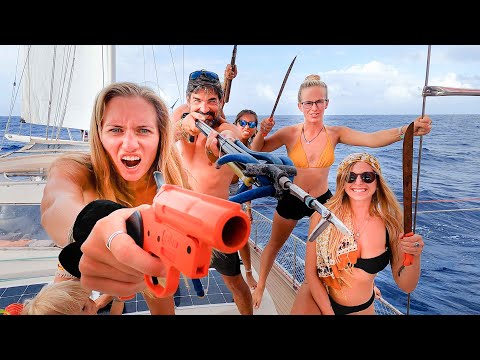Getting Aboard
It’s possible to hitch rides into the Pacific on yachts from California, Panama, New Zealand, and Australia, or around the yachting triangle Papeete-Suva-Honolulu. If you’ve never crewed before, consider looking for a yacht already in the islands. In Tahiti, for example, after a month on the open sea, some of the original crew may have flown home or onward, opening a place for you. Pago Pago, Vava’u, Suva, Musket Cove, and Port Vila are other places to look for a boat. Cruising yachts are recognizable by their foreign flags, wind-vane steering gear, sturdy appearance, and laundry hung out to dry. Good captains evaluate crew on personality, attitude, and a willingness to learn more than experience, so don’t lie. Be honest and open when interviewing with a skipper—a deception will soon become apparent.
Time of Year
The weather and seasons play a deciding role in any South Pacific trip by sailboat and you’ll have to pull out of many beautiful places, or be unable to stop there, because of bad weather. The prime season for rides in the South Pacific is May-October; sometimes you’ll even have to turn one down.
Be aware of the hurricane season: November-March in the South Pacific, July-December in the northwest Pacific (near Guam), and June-October in the area between Mexico and Hawaii. Few yachts will be cruising those areas at these times. A few yachts spend the winter at Pago Pago and Vava’u (the main “hurricane holes”), but most South Pacific cruisers will have left for hurricane-free New Zealand by October.
Also, know which way the winds are blowing; the prevailing trade winds in the tropics are from the northeast north of the equator, from the southeast south of the equator. North of the tropic of Cancer and south of the tropic of Capricorn the winds are out of the west. Due to the action of prevailing southeast trade winds, boat trips are smoother from east to west than west to east throughout the South Pacific, so that’s the way to go.
Yachting Routes
The common yachting route or “Coconut Milk Run” across the South Pacific utilizes the northeast and southeast trades: from California to Tahiti via the Marquesas or Hawaii, then Rarotonga, Niue, Vava’u, Suva, and New Zealand. Some yachts continue west from Fiji to Port Vila. In the other direction, you’ll sail on the westerlies from New Zealand to a point south of the Australs, then north on the trades to Tahiti.
Some 300 yachts leave the U.S. west coast for Tahiti every year, almost always crewed by couples or men only. Cruising yachts average about 150 km a day, so it takes about a month to get from the U.S. west coast to Hawaii, then another month from Hawaii to Tahiti. Most stay in the South Seas about a year before returning to North America, while a few continue around the world. About 60-80 cross the Indian Ocean every year (look for rides from Sydney in May, Cairns or Darwin from June-August, Bali from August-October, Singapore from October-December); around 700 yachts sail from Europe to the Caribbean (from Gibraltar and Gran Canaria October-December).
To enjoy the finest weather conditions many yachts clear the Panama Canal or depart California in February to arrive in the Marquesas in March. From Hawaii, yachts often leave for Tahiti in April or May. Many stay on for the Heiva i Tahiti festival, which ends on 14 July, at which time they sail west to Vava’u or Suva, where you’ll find them in July and August.
From New Zealand, the Auckland to Fiji yacht race in June brings many boats north. In mid-September the yachting season culminates in Port Vila and by late October the bulk of the yachting community is sailing south via New Caledonia to New Zealand or Australia to spend the southern summer there. In April or May on alternate years there’s a yacht race from Auckland and Sydney to Suva, timed to coincide with the cruisers’ return after the hurricane season.
Life Aboard
To crew on a yacht you must be willing to wash and iron clothes, cook, steer, keep watch at night, and help with engine work. Other jobs might include changing and resetting sails, cleaning the boat, scraping the bottom, pulling up the anchor, and climbing the main mast to watch for reefs. Do more than is expected of you. A safety harness must be worn in rough weather.
Anybody who wants to get on well under sail must be flexible and tolerant, both physically and emotionally. Expense-sharing crew members pay US$50 a week or more per person. After 30 days you’ll be happy to hit land for a freshwater shower. Give adequate notice when you’re ready to leave the boat, but do disembark when your journey’s up. Boat people have few enough opportunities for privacy as it is. If you’ve had a good trip, ask the captain to write you a letter of recommendation; it’ll help you hitch another ride.
Food for Thought
When you consider the big investment, depreciation, cost of maintenance, operating expenses, and considerable risk (most cruising yachts are not insured), travel by sailing yacht is quite a luxury. The huge cost can be surmised from charter fees. International law makes a clear distinction between passengers and crew. Crew members paying only for their own food, cooking gas, and part of the diesel are very different from charterers who do nothing and pay full costs. The crew is there to help operate the boat, adding safety, but like passengers, they’re very much under the control of the captain. Crew has no say in where the yacht will go.
The skipper is personally responsible for crew coming into foreign ports: he’s entitled to hold their passports and to see that they have onward tickets and sufficient funds for further traveling. Otherwise the skipper might have to pay their hotel bills and even return airfares to the crew’s country of origin. Crew may be asked to pay a share of third-party liability insurance. Possession of dope can result in seizure of the yacht. Because of such considerations, skippers often hesitate to accept crew. Crew members should remember that at no cost to themselves they can learn a bit of sailing and visit places nearly inaccessible by other means. Although not for everyone, it’s the way to see the real South Pacific, and folks who arrive by yacht are treated differently than other tourists.



